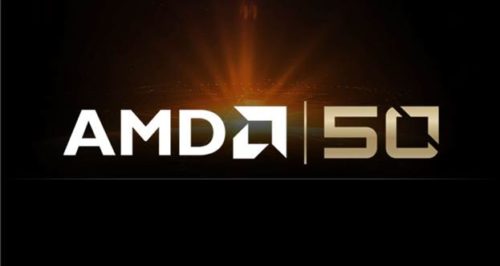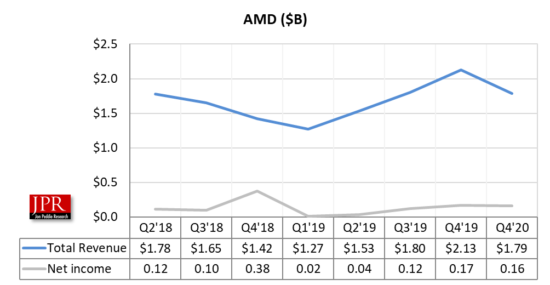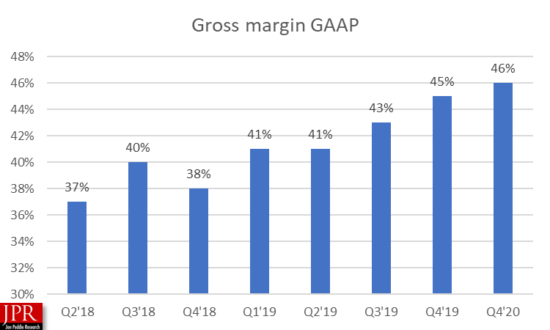Revenue for the quarter was up 41% from last year to $1.8 billion, GAAP profit was $162 million, up 912% from last year.

AMD’s first quarter was down from Q4, but up year to year in sales and profits.
Revenue was $1.79 billion, up 40% year-over-year primarily driven by higher Computing and Graphics segment revenue. Revenue was down 16% quarter-over-quarter due to lower revenue in both segments.
“We executed well in the first quarter, navigating the challenging environment to deliver 40% year-over-year revenue growth and significant gross margin expansion driven by our Ryzen and EPYC processors,” said Dr. Lisa Su, AMD president and CEO. “While we expect some uncertainty in the near-term demand environment, our financial foundation is solid and our strong product portfolio positions us well across a diverse set of resilient end markets. We remain focused on strong business execution while ensuring the safety of our employees and supporting our customers, partners, and communities. Our strategy and long-term growth plans are unchanged.”
Gross margin was 46% compared to 41% a year ago and 45% in the prior quarter primarily driven by Ryzen and EPYC processor sales.

Operating income was $177 million compared to operating income of $38 million a year ago and $348 million in the prior quarter. Operating income improved year-over-year primarily driven by revenue growth and a greater percentage of Ryzen and EPYC processor sales. On a sequential basis, operating income declined due to lower revenue and higher R&D expenses.
Net income was $162 million compared to net income of $16 million a year ago and $170 million in the prior quarter. Non-GAAP net income was $222 million compared to net income of $62 million a year ago and $383 million in the prior quarter.
Graphics group
Computing and Graphics segment revenue was $1.44 billion, up 73% year-over-year and down 13% quarter-over-quarter. Revenue was higher year-over-year driven by strong Ryzen processor and Radeon product channel sales. The quarter-over-quarter decline was primarily due to lower graphics processor sales.
Client processor average selling price (ASP) was up year-over-year driven by Ryzen processor sales. Client processor ASP was down slightly quarter-over-quarter due to higher notebook sales.
GPU ASP was lower year-over-year and quarter-over-quarter due to product mix.
Operating income was $262 million compared to $16 million a year ago and $360 million in the prior quarter. The year-over-year increase was driven by significantly higher revenue. The quarter-over-quarter decline was primarily due to lower revenue.

Enterprise, embedded, and semi-custom
The enterprise segment revenue was $348 million, down 21% year-over-year and 25% sequentially, primarily due to lower semi-custom sales, partially offset by higher EPYC processor sales.
Operating loss was $26 million compared to operating income of $68 million a year ago, which included a $60 million licensing gain. The decline from operating income of $45 million in the prior quarter was primarily due to lower revenue and higher operating expenses.
All Other operating loss was $59 million compared to operating losses of $46 million a year ago and $57 million in the prior quarter.
AMD has been steadily improving its gross margin.

AMD further strengthened its position as a data center compute and graphics processing solutions leader with new design wins and cloud deployments.
Lawrence Livermore National Laboratory, HPE, and AMD announced that the exascale-class supercomputer, El Capitan, powered by next generation AMD EPYC CPUs, next generation AMD Radeon Instinct GPUs, and open source AMD ROCm heterogeneous computing software is expected to be the world’s fastest supercomputer with more than 2 exaflops of double precision performance when delivered in early 2023.
AMD and its game console partners shared new details and specifications for the AMD-powered Microsoft Xbox Series X and Sony PlayStation 5 consoles expected to launch in the 2020 holiday season.
AMD announced the forthcoming AMD RDNA 2 gaming architecture will support Microsoft’s new DirectX 12 Ultimate API.
Outlook
Based on the current COVID-19 environment, global economic backdrop and customer demand signals, for the second quarter of 2020, AMD expects revenue to be approximately $1.85 billion, plus or minus $100 million, an increase of approximately 21% year-over-year and 4% sequentially. The year-over-year increase is expected to be primarily driven by growth of Ryzen and EPYC processor sales. The sequential increase is expected to be primarily driven by EPYC processor and semi-custom sales. AMD expects non-GAAP gross margin to be approximately 44% in the second quarter of 2020. The sequential decrease is expected to be primarily due to the initial ramp of next-generation semi-custom products.
Despite expectations of weaker COVID-19 related consumer demand in the second half of the year, AMD expects 2020 revenue to grow by approximately 25%, plus or minus 5 percentage points, compared to 2019 and non-GAAP gross margin to be approximately 45%.
What do we think?
AMD continues its growth and Wall Street likes what it hears and sees and so it betting forward by driving up the share price. On the 28th April, the day of AMD’s announcement, AMD share were going for $55.51 and Intel’s for $58.78. A year ago, Intel was over 2× over AMD at $57.61 to AMD’s $27.66.

The company has had a string of design wins with the PC OEMs, and in the cloud and enterprise, topped off by a win in the biggest fastest supercomputer—what’s not to like. Soon a new suite of consoles will be coming out, powered by AMD. This is probably the best condition and position the company has been in since it was founded over 50 years ago with innovative products in ever major platform.





